Eye On Hanoi
Reflections on Life in Hanoi
SOMEWHAT OF A TRAVEL GUIDE - PART 2
August 13, 2009

Ah, it’s not a bad life really. And I wish to enjoy it some more. So I shall lay my pen down, lie back further, read my book, enjoy the holiday, and pick up this entry again in a few days time on my return to Hanoi …

... I am now back in Hanoi and it is high time that I revisit my ‘travelogue’ on holiday destinations that I have enjoyed during my time in Vietnam. It has been over a year since I wrote the first part of this entry (check out Somewhat Of A Travelogue – Part 1), and it makes natural sense that it should be one of the final entries that I write for this journal before we de-post and return to Singapore in a few weeks time. In part one of this entry I presented my impressions of our holidays and trips to Ha Long Bay, Nha Trang, HCMC/Saigon, Da Lat, Dien Bien Phu, and Mui Ne. Since then, we’ve managed to fit in a few more gems here in Vietnam and some other spots in the region, so it’s now time to pen down my ideas on these places.
As per the first part on this topic and all my other entries, my comments here are my very subjective impressions of these locations and I would certainly recommend reviewing other sources if you are after a ‘what to do in such-and-such a place’. I try not to give advice on specific commercial entities such as hotels and restaurants, but from time to time I am so impressed with a place that it manages to sneak it’s way into these pages.
Hoi An / Danang
I would have found another reason to visit Hoi An, but when I first sniffed the chance to compete in the Vietnam Triathlon that was to be held there in August 2008 it gave us a prime excuse and time to go. It is one of the more popular destinations on the Vietnam tourist circuit, and it really was a lovely place to visit.
One would not believe it now, but in the 1st Century the harbour in Hoi An was the largest in all of South East Asia. For the Champa, it was for a period of time the main commercial centre of their empire. More recently, in the late 1500’s, the Nguyen Lords established it as trading port which was, once again, one of the busiest in the region. Alas, 200 years later, Hoi An became a quiet backwater when an emperor by the name of Gia Long rewarded the French for their help in over-throwing the Nguyen lords – he gave them Danang, just 30 kilometers up the road, as their new trading port.
So, Hoi An today is really a shell of what it used to be. But therein lies it’s beauty! The Old Town has been beautifully preserved and is the raison d’etre for this city being on the tourist map. What is now rightfully endowed as a UNESCO World Heritage Site is a delightful collection of old buildings that represent a collage of architectures of the various trading nations that long ago stopped at this port –perhaps, primarily Chinese and Japanese. The Old Town is lovely and is pretty much the only part of the city that you will want to visit. It is full of art shops, clothing shops, tailors who will spin you a garment overnight, shoe peddlers who will peddle you some shoes, and a fantastic selection of restaurants, cafes and bars.
Be warned though. Hoi An is small! In reality, you can do it in a day – but that of course would not allow you to try out all the foods available on the streets and in the bars, cafes, and restaurants. Conveniently though, Hoi An, like many ports, is located near the sea. And in this case, one of the most beautiful beaches that I have ever stayed on (for those with a war interest, not far north on this very long beach is the well known China Beach). In my opinion, it is the combination of the two that makes it such an great spot. Prance around the beach and waves all you will during the day, then head into the Old Town about 10 minutes away for lunch or an evening of walking the streets, checking out the art and the museums, getting measured up for a shirt or a dress or a pair of shoes, and enjoying a nice meal and drink. You can even check out an ancient Japanese covered bridge (which is one of these places that does stretch it somewhat as a place of cultural interest).
I’ve included Danang as a part of this section for no other reason than the fact that the city’s airport is the gateway to Hoi An. Danang is Vietnam’s fourth largest city, which is I suspect it’s only claim to fame - particularly from a tourist’s perspective. Danang is a city that you pass through.
Apart from three hours of horror competing in the Vietnam Triathlon, we very much enjoyed our time in Hoi An. And I got a great pair of casual shoes made for me for a mere USD20, so one cannot complain really. My only regret for our time there is that we did not schedule any time, or had no energy after the race, to check out My Son, which is another World Heritage Site focused around the monument and temples of the ancient Champa Kingdom. Do make time to see this place … and let me know what I missed.
Hue
Not far north, up the coast from Hoi An and Danang lies Hue. In fact, so close are the two locations that as you fly into Danang heading south from Hanoi, you are well established in the decent as you pass Hoi An on the starboard side of your aircraft. Yet, another UNESCO World Heritage Site (it turns out that there are 5 such sites throughout the whole of Vietnam) Hue is famous for having been the capital of Vietnam during the Nguyen Dynasty from 1805 to 1945. It is the Imperial Citadel and the tombs of the Nguyen emperors that are the primary source of attraction here. Sadly, Hue saw some extremely fierce fighting during the Vietnam / American War and as one travels to and from some of these attractions one sees the remains of past glorious monuments that have been all but obliterated by ordinances from both sides. But there is still much to see and enjoy in this town.
Having a general fascination with geology, my first fascination of Hue was actually during the final stages of the approach into the airport. And what exactly it is that I saw still has me stumped. My best guess at the moment to explain the kilometer after kilometer of bright white with myriads of what looked like large white wells, is that there must be some serious sea salt farming going on in the estuary between Hue and coast. But I’ve not been able to find anything or anyone that can confirm this for me. (Postscript: recent asking around has confirmed this to be true).


Another activity that I would have done had time permitted is a DMZ tour. Depending on the size of the map that you are looking at, Hue is inches south of the demilitarized zone (DMZ) that used to separate North and South Vietnam. Apparently it was not very demilitarized at all. For the war buffs there are apparently some excellent historical trips that one can do. Those into such history have advised me that if there is one war related tour you do in Vietnam, then a DMZ tour is the one to do. I am sorry that I had no time for it.
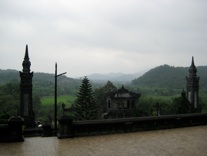
We only spent a few days in Hue, and I wish I had spent a few more so that I could have visited more of these tombs. One day I do intend to return to Hue. Aside from seeing more of the monuments and tombs, the main draw card for me will be the amazing embroidery that I saw during our stay. Some of the pieces we saw at the XQ shop there were simply exquisite. Too large and too expensive for our budget for now, I swear to return again when I am a larger and richer man!
Ha Giang
Magical. And also written about in a previous entry . Please check out Off The Beaten Track - Ha Giang Cycling Trip for the “novel” I wrote covering a very impressive cycling trip that a friend and I did up in this most northern province of Vietnam, tucked right up against the Chinese border.
Whale Island
Whale Island is a place that we have been wanting to visit for sometime now, and with only a few weeks remaining of our time here in Hanoi, it will no doubt be our last holiday destination of this ‘tour of duty’.
Ile De La Baleine, as it is called by the French owners, is actually a resort sitting on a tiny island called Hon Ong up in Van Phong Bay north of Nha Trang. We began our journey from Hanoi, flying to Nha Trang then taking a 2.5 hour minibus ride north, followed by a 20 minute boat ride out to the island. Due to delayed flights we arrived in the dark, which made waking up the following day to the early morning rays all the more exciting. As I stepped out the door with the wee girl at 5.30am (the sun gets up early at the moment in Vietnam, and this means my wee girl gets up and wants to play early too) the sight from our front door step across the flat waters of the bay back towards the mainland was perfect.

Whale Island also provided me with a chance to go underwater again. Rainbow Divers, whom I had been with once before in Nha Trang almost three years earlier have a centre at one end of the resort and run trips from there. Given that me lady and I did not envisage the wee girl enjoying 5 hours on a small boat in the heat, we opted out of the major option, which would have enabled us to go visit some spots a bit further afield. But I did take advantage of the centre to do an afternoon shore dive. Many people under rate shore dives, but I’ve always found them such a relaxed, quiet, and more social way to dive – away from the noise of the boat and the compressor. As it was, there was not much to see off the shore from the resort. Just a few small rocky reefs. Stuff that I saw the following day by snorkeling. But sometimes it’s nice just to go out, get wet, and have a swim around underwater. Incidentally, as I found with them in Nha Trang, Rainbow Divers are the most professional dive outfit that I have come across in South East Asia – I’d go with them again anytime.
A nice additional feature on the island is that, while small, it is big enough to have a walk around. The island is totally clad in tropical forest and it takes in the order of one and a half hours to walk around. If you are the type who enjoys sunrises and sunsets then there are a couple of well positioned rocks within the jungle you can climb up to welcome or farewell the day.
Ile De La Baleine was certainly worth visiting for someone living in Vietnam (and for the large part of their clientele that flies in direct from Europe). With delayed flights, it ended up being a bit of a journey to get to from Hanoi with the wee girl, but as a quiet secluded place to go to read a book, have a dive, do some snorkeling, kayaking, windsurfing, go for a bush walk, and generally just chill then you can’t get much better. I’d probably leave the wee girl behind the next time though ;).
The Hanoi Hinterland
It only hit me about 6 months ago that, while we had done a lot of travelling around Vietnam, most of it had involved heading to the airport or train station and getting far away from Hanoi. In the two and a half years of living here, I had actually seen very little of the countryside surrounding Hanoi. You know, the stuff that you could do as a day trip. Not having my own car is not really an excuse, as it is pretty affordable to hire a car and driver for the day. In some ways it has been the state of the roads and the highways around Hanoi that has kind of scared me off visiting some of these places. And with just weeks to go it is looking like I will not get to complete my list of locations around Hanoi that I would like to get to. The following paragraphs highlight some of the locations that I have seen.
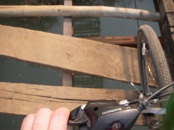

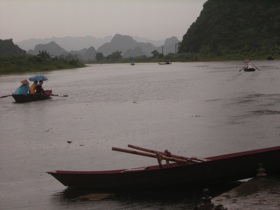

The surrounds of Hanoi hold many options and I’ve been somewhat of a fool not to get on to them earlier. Like many, the roads have stopped me exploring them as much as I would have liked. If I had been more ‘on to it’ I would have made more of an effort to get to places like Ba Vi, Yen Tu, and the numerous other national parks not too far from Hanoi. With 4 weeks to go there is still time to get out a bit, and Yen Tu is the top of my list as I’ve heard some good reports about it – so perhaps this section will see an update sometime soon. I hope so.
Beyond Vietnam - Bangkok
Most people know Bangkok, so I’ll not delve into this spot too much. But for one living in Hanoi, Bangkok can be a nice release if you need a fix of serious shopping in monstrous air-conditioned shopping malls or a more sophisticated nightlife. At just under 2 hours away by air and with a number of airlines flying the route, it is a relatively cheap and easy place to get to for a quick break. I’ve managed two trips there during our time in Hanoi. There are some who have escaped to Bangkok on almost all of their breaks and I have always found that a bit of a shame since there are so many interesting spots in Vietnam (and even Cambodia and Laos) to visit.
Beyond Vietnam - Siem Reap, Cambodia
Many a time I have been disappointed in visiting popular tourist destinations. Like a talked up movie, they often fall below ones expectations. With this in mind, I had never previously had an interest in visiting Siem Reap, which is the gateway city to the temples of Angkor. After more than ten years of living in South East Asia, it took the Angkor Wat International Half Marathon to finally get me to visit the place.

Very briefly, Angkor was the location of the Khmer empire from the 9th to the 13th Century. Originally followers of Hinduism, before adopting Buddhism in the late 12th Century, the architecture reflects both religions as well as some of the indigenous religious cults from the area. Interestingly, some put the adoption of Buddhism as the religion of the empire as one of the causes of the rapid decline of the Angkor civilization (though regular invasions from Thailand did not help either). At it’s height, the empire would have been massive with an estimated urban sprawl of 3,000 square kilometers which apparently could have supported up to one million inhabitants. Luckily though, the most interesting spots are within a few kilometers of each other and within a short drive or cycle from Siem Reap itself.
But even the main section of the Angkor Archeological Park is quite a bit of work to get through, and the fact that there is a 3-day pass option to the complex is a good indication to the size of it. Since I was there for the half-marathon (or at least me lady was – I was watching) I did not have enough time to see all I wanted to. It costs a bit more for three days, but this place is magical and well worth the time and the money. I will be back though, with the race being a good excuse to keep returning annually, and will set aside more time in the future. And I think I’ll hire a bicycle to get around – even with all the tourists it’s a pretty quiet place and cycling around will add to the romance of it.
What was also a pleasant surprise about this location is the small city of Siem Reap itself. It is a quiet town with a wonderful selection of bars, restaurants, cafes, and markets to keep one occupied in the evenings or as a retreat from walking around the temples during the heat of the day. Actually, the scene surrounding Pub Street and it’s adjacent streets made me think that such a scene could be replicated in some of the streets of the Old Quarter of Hanoi – something that might make tourists stay an extra day and spend a little more money. There’s a thought for Hanoi’s city planners eh!

I do not wish to make comment on the horrors of life under Pol Pot, other than to say perhaps the only disappointment of Siem Reap was that many of the hotel and other building facades were pretty ugly Soviet looking concrete monoliths, very probably designed by those with high communist ideals after the artists, architects, intellectuals, professionals and perhaps more than two million others were vanquished by that horrid and mad regime.
Siem Reap taught me that sometimes there are very good reasons for some places being such tourist meccas. It threw up some very pleasant surprises and I will definitely be back again. In fact, I am already planning to attend the next half marathon there in December of this year. If you do go yourself, then I would strongly recommend reading up on the place before you head there. It is so fascinating that it really is worth knowing a little bit about it before you do.
And damn, if only I’d come here a few years ago – I may have bumped into Angelina Jolie filming Tomb Raider.
Beyond Vietnam - Luang Prabang, Laos
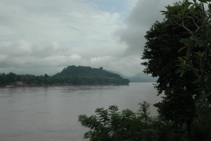
The flight itself into Luang Prabang is an eye opener of what awaits one at the destination. Whether coming in from Thailand in the west, Hanoi in the east, or Vientiane or Cambodia in the south, the flight over the densely jungled rugged mountain ranges into the valley through which the Mekong River flows is awesome. Being the type of guy who must have a window seat my head was glued out the window for the entire flight. As the aircraft circles the town on the river and approaches the airport one can’t help but think ‘wow, I am going to enjoy this’. And speaking of the flight, I flew there on a small ATR turbo prop – now ain’t there a real ‘holiday feeling’ about flying to your destination on something small rather than one of those monster buses in the sky, and being able to walk out to your aircraft?
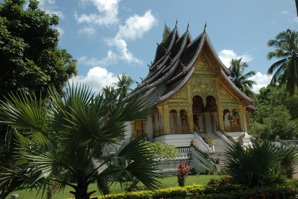
Luang Prabang has a bit of something for everyone. For the adventurer there is trekking, mountain biking, elephant riding. And we’re not just talking about day tripping stuff – go off into the bush for days if you want. For the cultural buffs, need I say anything more than that the town is a UNESCO World Heritage site, due to it’s well preserved fusion of traditional Lao architecture and that built by the French colonial authorities? For those after some quiet time, there is the option to stay in hotels with grand gardens and read a book or to pop down to the river or head into the quiet town for a coffee. There are also some caves and some picturesque waterfalls to visit.
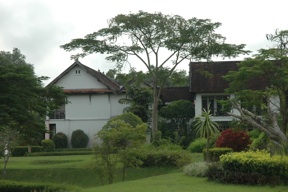
Will I be heading back to Luang Prabang again? Most definitely! With a heat that New Zealand very rarely sees, my dear parents were happy to simply potter around town and enjoy the gardens, so I never made it to the waterfalls or elephant rides or mountain bikes. Having said that, even an active person like myself enjoyed the more relaxed pace for a change. I will return one day to explore further afield. That aside, the quiet simplicity of this town will be enough to lure me back to retreat from the pace of city life from time to time.
More so by accident than by design, this trip taught me that off season travel is not a bad idea. Ok, depending upon the location one might hit inclemental weather, but it does mean cheaper flights, cheaper hotels, cheaper tripping around, and most importantly, fewer people and a much quieter and personal holiday.

That concludes the second section of my ‘travelogues’ around Vietnam and nearby destinations. The policy of me lady and I on this posting was to return to Singapore (or New Zealand for that matter) less and focus our holidays on the region. As a result we’ve managed many great short and long trips during our three years in Hanoi. There are some places that I have not made it to yet. For example, I’ve not explored the Mekong Delta area south and west of HCMC, nor the island of Phu Quoc, nor much of the central highlands. But I’ve figured that Singapore is not too far from Vietnam, and it’s even closer to HCMC than Hanoi is, so there is time to do those another day.
As I look back on the places that I have been to, there are a few that stand out and I hope that I can get back to again one day. Ha Giang, for the ruggedly impressive scenery; Da Lat, not for the town itself, but to explore further the trekking and mountain biking available there; Mui Ne, for the beach; Siem Reap, for the Temples of Angkor; and Luang Prabang, for the outdoors in the jungle and the serenity of the town.
And of course, from a few weeks time when we will no longer call it home, Hanoi will naturally become a holiday destination – it is, after all, the place where my wee girl was born.